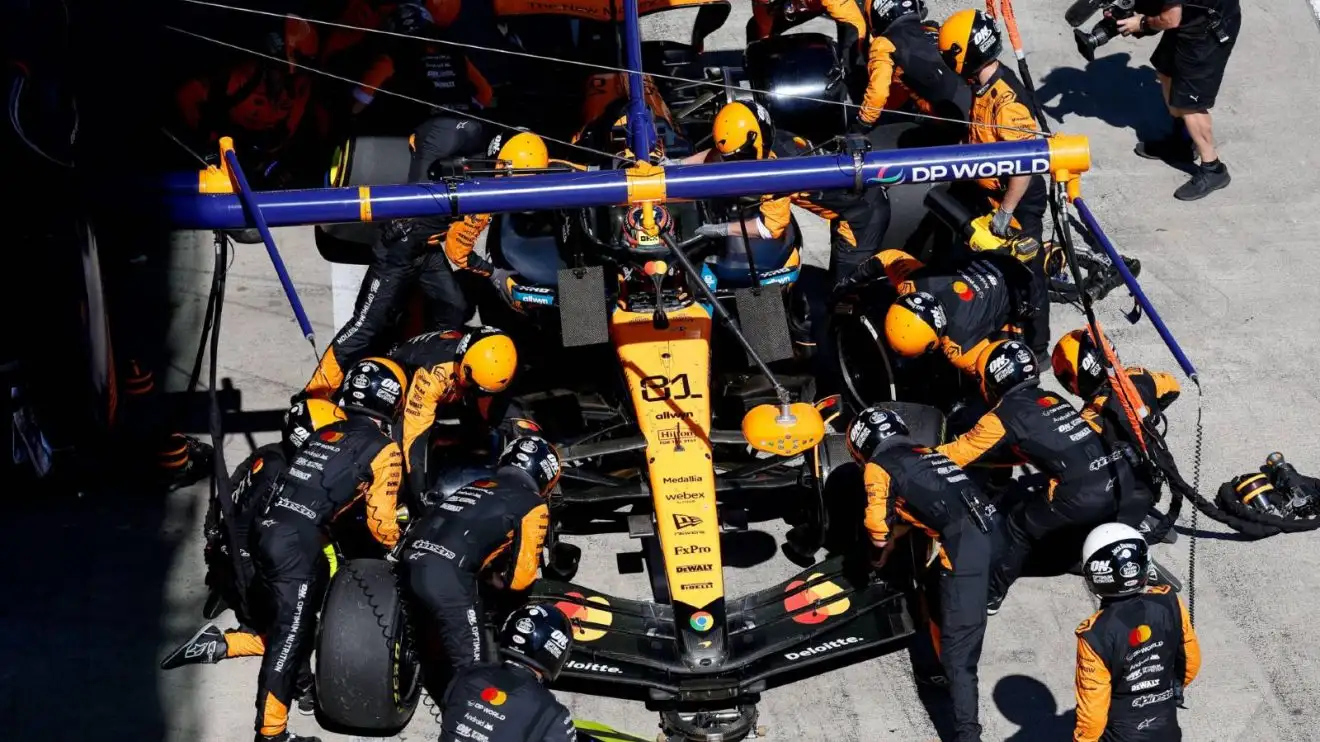Mandatory two-stop proposal put on hold as F1 teams express misgivings

The idea of introducing a mandatory two-stop strategy to F1 has been put on hold, but team support is said to be minimal.
An idea to introduce mandatory two-stop strategies is currently on pause, but many of the teams are believed to be against the suggestion as a whole.
A meeting of the F1 Commission last week saw a discussion around whether the sport should introduce a regulation to enforce a minimum of two mandatory pit stops per Grand Prix.
Teams push back against two-stop proposal
An idea to explore the possibility of two stops being made mandatory in Formula 1 was one of the topics brought up at last week’s meeting of the F1 Commission, in which the teams sat down with the FIA and Formula One Management to discuss various proposals and suggestions.
Following the meeting, a statement from the FIA stated that the idea had been tabled but, without any changes agreed, talks on the matter will be deferred until during the F1 2026 season with an eye to future introduction.
“A proposal to explore mandatory two pit stops for grands prix was discussed along with adjustments to tyre specifications, tyre-life limits and the use of three compounds during the race,” read the FIA’s statement.
“The discussion centred on feedback on analysis and simulations from teams and Pirelli.
“No changes were presently agreed, but it was agreed that talks on this topic would continue during the 2026 season.”
However, various paddock sources have suggested that, while these talks may be yet to occur, there appears to be little chance of the idea gaining much traction with the teams.
Indeed, PlanetF1.com understands that the vast majority of the teams pushed back with misgivings about the topic, with the feeling being that a mandatory two-stop strategy would significantly reduce variability and variety of approach to a race, rather than improving it.
With huge regulation changes on the way for F1 2026, it’s understood that the consensus is to sit and wait to monitor the effect of the chassis aero and power unit regulation upheaval before potentially re-approaching the topic.
With the Pirelli tyres becoming more and more resilient, a proposal to discuss what could be considered to try shaking up the prevalence of one-stop strategies was put forward by FOM, with ideas including a mandatory two-stop as well as the use of softer Pirelli compounds, as the teams were informed of the risk of almost all races now being one-stop due to the longevity of the current compounds.
On that basis, the ideas gained enough credence to warrant discussion at the F1 Commission, after Pirelli carried out some analysis, but the matter did not get as far as being put to a vote.
F1 CEO Stefano Domenicali is said to have agreed with the teams’ position that a mandatory two-stop strategy would reduce variability.
It’s not the first time a mandatory two-stop strategy has been proposed, with the idea also put forward in 2018.
Pirelli boss Mario Isola said at the time that he was “not sure that is the right solution because you have the risk of all the cars stopping on the same lap,” and this position hadn’t changed when the Italian recently explained how, when the teams were privately asked to predict strategies based on three selected compounds for a race weekend, the majority of the teams still converged upon the same strategy.
“They were basically replicating the same strategy,” he said. “So when you put more constraints, the risk is that everyone is going in the same direction.”
More on the two-stop strategy proposal
👉 From engineering to entertainment: Why F1’s mandatory two-stop idea misses the point
👉 Have your say: Are mandatory two-stop F1 races a good idea?
Speaking at the FIA Press Conference in Brazil, ahead of the F1 Commission meeting, the topic was broached as some of the team principals were asked how F1 can deliver a solution to try moving away from a swathe of one-stop races.
“I think everyone likes two stops or more, but we have to be careful,” said Racing Bulls’ Alan Permane.
“So we’ve got our guys looking at it at the moment – our strategy and tyre guys are looking at it closely. I think one of the things that makes a two-stop race tricky is when the tyres aren’t really suited for two stops.
“So you need to have tyres that demand the two-stop race. If you force a two-stop, you can end up with everyone doing the same strategy and actually have the opposite effect.
“And don’t forget, we’ve seen plenty of races with one guy on a one-stop and one guy on a two-stop, and then the guy on a one-stop being chased down by the two-stop – but that will obviously disappear.
“So I think we need to think very carefully. And we are. And I’m sure the F1 Commission will debate it, and I’m sure we’ll come to the right answer.
McLaren’s Andrea Stella agreed, calling for “prudence” on the matter.
“I think the tyres remain the fundamental factor to have some variability in the race,” he said.
“And in particular, whenever there’s some degradation, I think we can see overtaking and pit stops.
“At the same time, for 2026 – like we said before – we have so much change going on, and I think we should observe also what kind of racing we are going to have before we change the technical side and also the rules of the game.
“So I would invoke a little bit of prudence from this point of view. Let’s observe what happens in 2026, and then we can adapt from a sporting point of view to make sure that the entertainment and the racing are at the right level.”
Williams’ James Vowles said the imperative matter at present should be on further refining the parameters of the tyres to deliver a greater disparity between compounds in terms of longevity and performance.
“My biggest worry would be that we end up, all of us, doing the same strategy to within a lap of each other because you’re forced that way because of the two stops,” he said.
“So, to the key point, let’s get the key foundations right, which is tyre degradation and the gaps between the tyres.
“And I don’t mind a forced rule then that puts us in that circumstance, but I have a worry that immediately where we are now – I think you’ll get less variability in next year’s races, and that concerns me.”
Read Next: Racing Bulls showcase fresh livery update for Las Vegas Grand Prix





